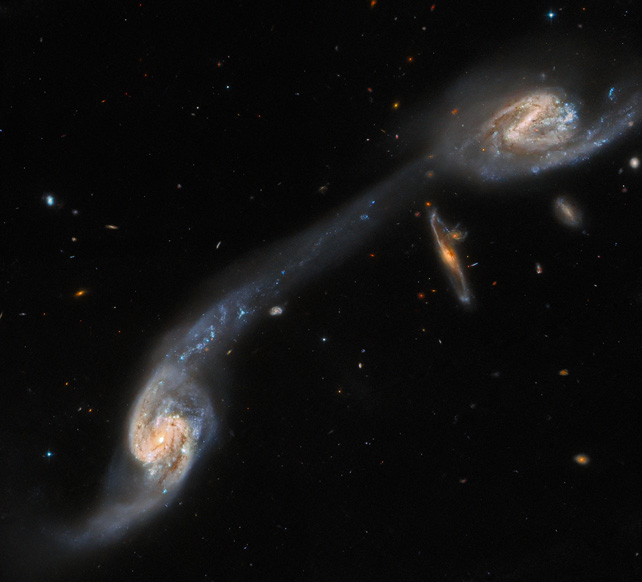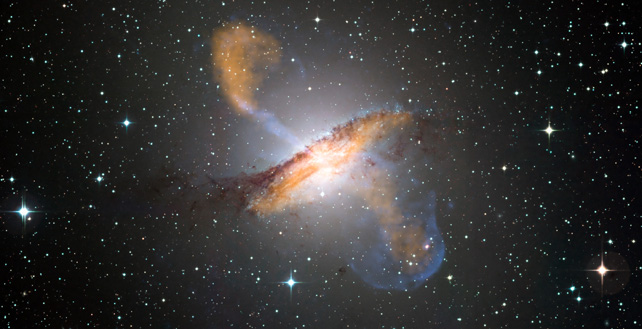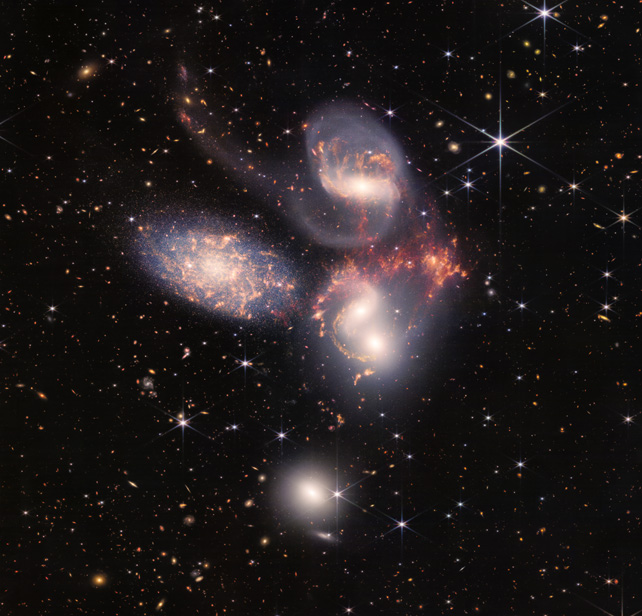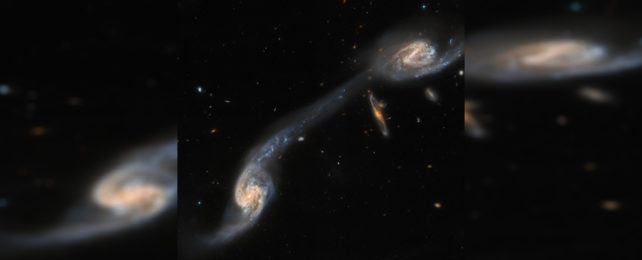Sometimes it's tempting to imagine a supernatural hand behind the arrangement of celestial bodies.
But the Universe is big, huge even, and nature's flow presents many fascinations.
So it is with the galactic triplet Arp 248, an arrangement of interacting galaxies that's both visually and scientifically fascinating.
Arp 248 is a trio of small interacting galaxies around 200 million light-years away in the constellation Virgo.
The image shows two of Arp 248's galaxies flanking another smaller unrelated galaxy in the background.
The galaxies are connected by a stream of stars, gas, and dust, created as the galaxies tug on one another gravitationally.

Astronomers call the streams "tidal tails." When dusty and gas-rich galaxies like Arp 248 merge, the merger frequently forms tails.
The tails are made of material from the outer spiral disks of the merging galaxies, and they host active star formation indicated by blue.
The top image is from an observing project examining two collections of unusual galaxies involving Halton Arp. Arp was an American astronomer who created the Atlas of Peculiar Galaxies in 1966.
The Atlas contains 338 galaxies chosen for their unusual shapes. He intended for it to highlight the variety of peculiar structures that galaxies take.
We now know these galaxies take such strange shapes because they're interacting and potentially merging. Arp disagreed with that interpretation and said the unusual forms were due to ejections.

But in any case, Arp realized astronomers weren't very knowledgeable about how galaxies change over time, and he intended that astronomers could use his Atlas to study galaxy evolution.
The second collection of unusual galaxies in the observing project is called A Catalog of Southern Peculiar Galaxies and Associations. It was published in 1987 by Arp and his colleague Barry Madore. The Catalog contains 25 different varieties of objects, including galaxies with tails.
Astronomers have expanded their knowledge of interacting galaxies, and galaxy mergers since the Atlas and the Catalog were published. We know that mergers play an important role in galaxy evolution.
As astronomers study interacting galaxies in more detail, they're uncovering a new class of objects that they call "intergalactic star-forming objects" (ISFOs.) ISFOs are a broad class of objects that capture the different types that form when galaxies interact.
ISFOs can form due to tidal interactions and the ram-sweeping of material from interacting galaxies. They can also develop due to the inflow of gas and dust to the tails and through a combination of all these processes.
ISFOs can range in mass from super star clusters to what astronomers call "tidal dwarf galaxies" (TDGs.) A 2012 paper based on the Sloan Digital Sky Survey estimated that about 6 percent of dwarf galaxies could have tidal origins.
ISFOs are often bound gravitationally to the galaxies, but how many stay bound and for how long is still an open question.
Sometimes material from the tidal streams will flow back into the galaxies, triggering more star formation. The leftover material from all this interaction enriches the interstellar medium with dust and metals.

Astronomers now think that about 25 percent of galaxies are currently merging with other galaxies. Even more of them are interacting gravitationally, if not merging, according to the Harvard Center for Astrophysics.
Our Milky Way galaxy is evidence of this, as it cannibalized gas and even stars from the Magellanic Clouds and the Sagittarius Dwarf Galaxy. And in several billions of years, the Milky Way and the Andromeda Galaxy will merge. Who knows what behemoth might arise from that event?
How supermassive black holes (SMBHs) grow so massive is also an open area of inquiry. Astrophysicists know that mergers are part of SMBH's growth process, but there's a lot they don't know.
The Hubble Space Telescope's Advanced Camera for Surveys (ACS) scrutinized this assortment of unusual interacting galaxies to lay the groundwork for more detailed study in the future.
The Hubble will examine some of these targets with its other instruments, and so will the James Webb Space Telescope and ALMA. Observing time on these telescopes is always in high demand, so this project will help astronomers allocate time better.
This article was originally published by Universe Today. Read the original article.
